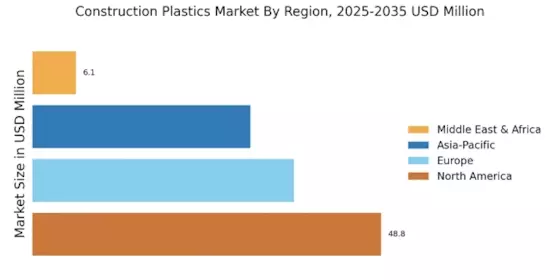Rising Demand for Lightweight Materials
The Construction Plastics Market experiences a notable increase in demand for lightweight materials, which are essential for enhancing energy efficiency and reducing transportation costs. As construction projects evolve, the need for materials that offer strength without the added weight becomes paramount. Lightweight plastics, such as polycarbonate and PVC, are increasingly favored for their durability and ease of handling. In recent years, the market for lightweight construction materials has expanded, with projections indicating a growth rate of approximately 5% annually. This trend is likely to continue as builders seek to optimize their supply chains and improve overall project efficiency, thereby driving the Construction Plastics Market forward.
Increased Focus on Sustainable Practices
Sustainability has emerged as a critical driver within the Construction Plastics Market, as stakeholders increasingly prioritize eco-friendly materials. The shift towards sustainable construction practices is evident, with many companies adopting recycled plastics and bioplastics to minimize environmental impact. Recent data suggests that the use of recycled plastics in construction could reduce carbon emissions by up to 30%. This growing emphasis on sustainability not only aligns with regulatory requirements but also appeals to environmentally conscious consumers. As a result, the Construction Plastics Market is likely to witness a surge in demand for sustainable materials, fostering innovation and new product development.
Urbanization and Infrastructure Development
Urbanization continues to be a significant driver for the Construction Plastics Market, as rapid population growth in urban areas necessitates extensive infrastructure development. The demand for housing, transportation, and public facilities is escalating, leading to increased construction activities. Recent statistics indicate that urban areas are expected to house nearly 70% of the global population by 2050, creating a pressing need for efficient building materials. Consequently, the Construction Plastics Market is likely to benefit from this trend, as plastics offer versatile solutions for various applications, including insulation, piping, and structural components. This urban expansion is expected to sustain market growth in the coming years.
Technological Innovations in Material Science
Technological advancements in material science are significantly influencing the Construction Plastics Market. Innovations such as 3D printing and advanced polymer formulations are enabling the creation of high-performance plastics that meet the rigorous demands of modern construction. For instance, the introduction of smart plastics that can adapt to environmental conditions is gaining traction. Furthermore, the market is projected to grow at a compound annual growth rate of 6% over the next five years, driven by these technological innovations. As construction companies increasingly adopt these advanced materials, the Construction Plastics Market is poised for substantial growth, reflecting the ongoing evolution of construction methodologies.
Regulatory Support for Plastic Use in Construction
Regulatory frameworks are increasingly supporting the use of plastics in construction, which serves as a vital driver for the Construction Plastics Market. Governments worldwide are implementing policies that encourage the adoption of innovative materials that enhance building performance and sustainability. For example, regulations promoting energy-efficient building practices often favor the use of advanced plastics due to their insulating properties. This regulatory support is likely to stimulate market growth, as construction firms seek to comply with new standards while optimizing their material choices. As a result, the Construction Plastics Market is expected to expand, driven by favorable policies and incentives.


















Leave a Comment